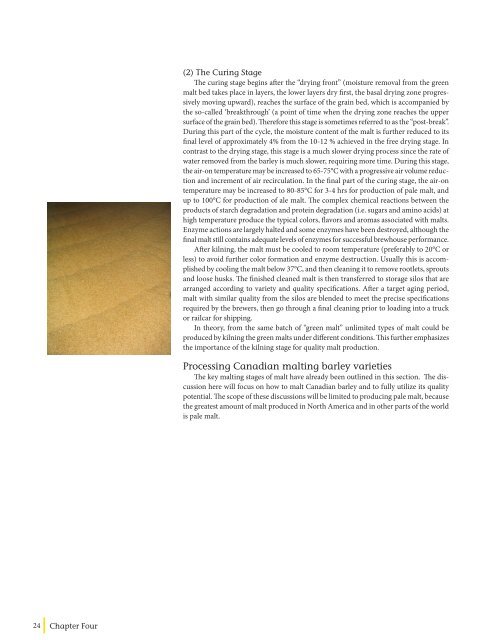MALTING QUALITY TRAITS - Canadian Malting Barley Technical ...
MALTING QUALITY TRAITS - Canadian Malting Barley Technical ...
MALTING QUALITY TRAITS - Canadian Malting Barley Technical ...
Create successful ePaper yourself
Turn your PDF publications into a flip-book with our unique Google optimized e-Paper software.
24<br />
Chapter Four<br />
(2) The Curing Stage<br />
The curing stage begins after the “drying front” (moisture removal from the green<br />
malt bed takes place in layers, the lower layers dry first, the basal drying zone progressively<br />
moving upward), reaches the surface of the grain bed, which is accompanied by<br />
the so-called ‘breakthrough’ (a point of time when the drying zone reaches the upper<br />
surface of the grain bed). Therefore this stage is sometimes referred to as the “post-break”.<br />
During this part of the cycle, the moisture content of the malt is further reduced to its<br />
final level of approximately 4% from the 10-12 % achieved in the free drying stage. In<br />
contrast to the drying stage, this stage is a much slower drying process since the rate of<br />
water removed from the barley is much slower, requiring more time. During this stage,<br />
the air-on temperature may be increased to 65-75°C with a progressive air volume reduction<br />
and increment of air recirculation. In the final part of the curing stage, the air-on<br />
temperature may be increased to 80-85°C for 3-4 hrs for production of pale malt, and<br />
up to 100°C for production of ale malt. The complex chemical reactions between the<br />
products of starch degradation and protein degradation (i.e. sugars and amino acids) at<br />
high temperature produce the typical colors, flavors and aromas associated with malts.<br />
Enzyme actions are largely halted and some enzymes have been destroyed, although the<br />
final malt still contains adequate levels of enzymes for successful brewhouse performance.<br />
After kilning, the malt must be cooled to room temperature (preferably to 20°C or<br />
less) to avoid further color formation and enzyme destruction. Usually this is accomplished<br />
by cooling the malt below 37°C, and then cleaning it to remove rootlets, sprouts<br />
and loose husks. The finished cleaned malt is then transferred to storage silos that are<br />
arranged according to variety and quality specifications. After a target aging period,<br />
malt with similar quality from the silos are blended to meet the precise specifications<br />
required by the brewers, then go through a final cleaning prior to loading into a truck<br />
or railcar for shipping.<br />
In theory, from the same batch of “green malt” unlimited types of malt could be<br />
produced by kilning the green malts under different conditions. This further emphasizes<br />
the importance of the kilning stage for quality malt production.<br />
Processing <strong>Canadian</strong> malting barley varieties<br />
The key malting stages of malt have already been outlined in this section. The discussion<br />
here will focus on how to malt <strong>Canadian</strong> barley and to fully utilize its quality<br />
potential. The scope of these discussions will be limited to producing pale malt, because<br />
the greatest amount of malt produced in North America and in other parts of the world<br />
is pale malt.


